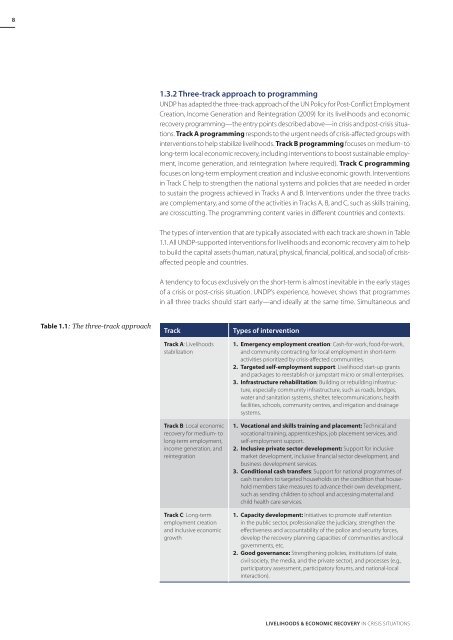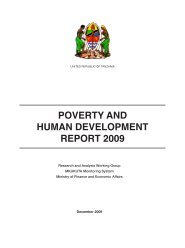Download PDF (4.08 MB) - ReliefWeb
Download PDF (4.08 MB) - ReliefWeb
Download PDF (4.08 MB) - ReliefWeb
Create successful ePaper yourself
Turn your PDF publications into a flip-book with our unique Google optimized e-Paper software.
8<br />
1.3.2 Three-track approach to programming<br />
UNDP has adapted the three-track approach of the UN Policy for Post-Conflict Employment<br />
Creation, Income Generation and Reintegration (2009) for its livelihoods and economic<br />
recovery programming—the entry points described above—in crisis and post-crisis situations.<br />
Track A programming responds to the urgent needs of crisis-affected groups with<br />
interventions to help stabilize livelihoods. Track B programming focuses on medium- to<br />
long-term local economic recovery, including interventions to boost sustainable employment,<br />
income generation, and reintegration (where required). Track C programming<br />
focuses on long-term employment creation and inclusive economic growth. Interventions<br />
in Track C help to strengthen the national systems and policies that are needed in order<br />
to sustain the progress achieved in Tracks A and B. Interventions under the three tracks<br />
are complementary, and some of the activities in Tracks A, B, and C, such as skills training,<br />
are crosscutting. The programming content varies in different countries and contexts.<br />
The types of intervention that are typically associated with each track are shown in Table<br />
1.1. All UNDP-supported interventions for livelihoods and economic recovery aim to help<br />
to build the capital assets (human, natural, physical, financial, political, and social) of crisisaffected<br />
people and countries.<br />
A tendency to focus exclusively on the short-term is almost inevitable in the early stages<br />
of a crisis or post-crisis situation. UNDP’s experience, however, shows that programmes<br />
in all three tracks should start early—and ideally at the same time. Simultaneous and<br />
Table 1.1: The three-track approach<br />
Track<br />
Track A: Livelihoods<br />
stabilization<br />
Track B: Local economic<br />
recovery for medium- to<br />
long-term employment,<br />
income generation, and<br />
reintegration<br />
Track C: Long-term<br />
employment creation<br />
and inclusive economic<br />
growth<br />
Types of intervention<br />
1. Emergency employment creation: Cash-for-work, food-for-work,<br />
and community contracting for local employment in short-term<br />
activities prioritized by crisis-affected communities.<br />
2. Targeted self-employment support: Livelihood start-up grants<br />
and packages to reestablish or jumpstart micro or small enterprises.<br />
3. Infrastructure rehabilitation: Building or rebuilding infrastructure,<br />
especially community infrastructure, such as roads, bridges,<br />
water and sanitation systems, shelter, telecommunications, health<br />
facilities, schools, community centres, and irrigation and drainage<br />
systems.<br />
1. Vocational and skills training and placement: Technical and<br />
vocational training, apprenticeships, job placement services, and<br />
self-employment support.<br />
2. Inclusive private sector development: Support for inclusive<br />
market development, inclusive financial sector development, and<br />
business development services.<br />
3. Conditional cash transfers: Support for national programmes of<br />
cash transfers to targeted households on the condition that household<br />
members take measures to advance their own development,<br />
such as sending children to school and accessing maternal and<br />
child health care services.<br />
1. Capacity development: Initiatives to promote staff retention<br />
in the public sector, professionalize the judiciary, strengthen the<br />
effectiveness and accountability of the police and security forces,<br />
develop the recovery planning capacities of communities and local<br />
governments, etc.<br />
2. Good governance: Strengthening policies, institutions (of state,<br />
civil society, the media, and the private sector), and processes (e.g.,<br />
participatory assessment, participatory forums, and national-local<br />
interaction).<br />
Livelihoods & Economic Recovery in Crisis Situations





